Extremely Rare, rated R/4 Early American Shaw Patent antique sewing machine, c1863
July 23, 2018
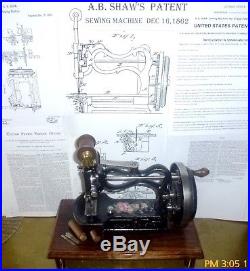
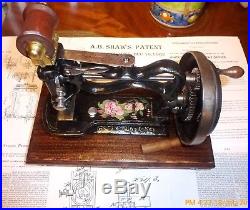
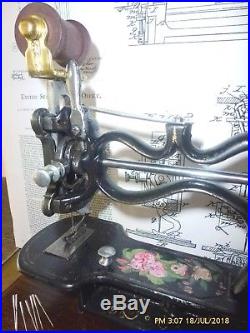
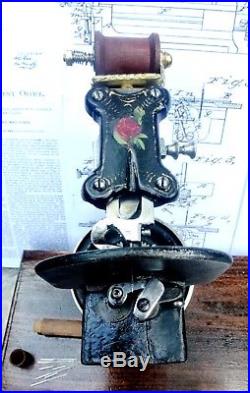
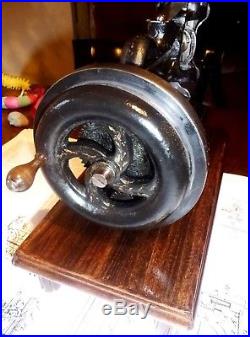
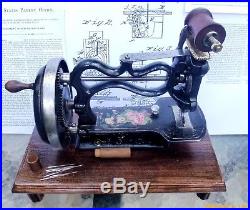
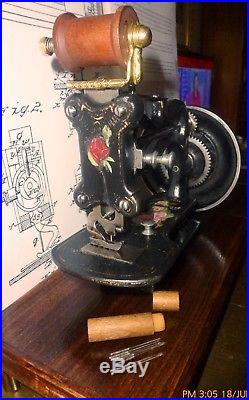
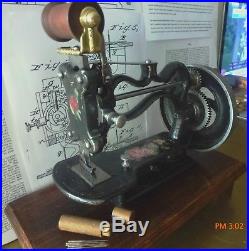
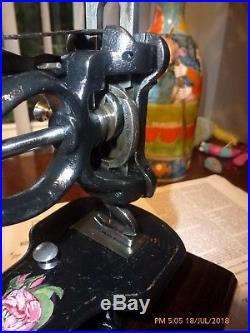
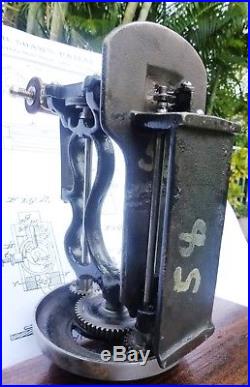

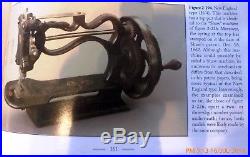

Shaws Patent Sewing Machine. Being by appearance and all definitions one of. Type Antique chain stitch sewing machines this featured machine is technically “Shaw’s Patent Sewing Machine “. It is the fundamental inventions by A. Shaw and has the Patent #307,202 filed on Dec 16 1862 and being used in manufacturing of a great number of. On the featured machine the Pressure spring (see pic # 2) there are markings on the top of foot pressure spring -“Patented Dec 16 1862″. This particular patented improvement is dealing with t. He feed-lever “H” carrying the jointed feeding and pressing foot “L. See fig 1 & Fig 2 in the attached Patent. You can also see it as the background on some of the pics. Is fitted into a vertical slot in the stand “A”, the part received in the said slot having rounded protuberances on each side to bear against the sides of the slot to permit the free vibration of the lever, as well as a free upward and downward movement. The lever is made with a yoke “H” for the reception of the cam “C” and fitted with a set screw “T” to regulate the feed, as in many other New England type sewing-machines. The downward pressure upon lever is produced by a spring, to permit it to have an independent upward and downward movement. Between the spring and the cam “d” there is arrangement for a pin and a hole for pin to pass freely through. While the needle is in the fabric and the lever is returning with the foot “L” prior to a new feed-movement, the cam raises the leaf removing the pressure of the spring from the lever and foot, allowing foot to slide freely over the cloth. These small, hand-turned sewing machines were manufactured by six companies. In The Carter Bays’ Encyclopedia of Early American & Antique sewing machines (III) where the same machine is being featured on page #161 fig # 2-194 with the comments that two-or three digit number painted underneath (also see fig 2-226). On this machines these 3 (three) painted numbers are “58”. Most likely these are being a serial numbers. Many years ago I used to have the similar machine with # “114”. The exactly the same machine being featured in Encyclopedia is rated as “R-4″. In the rarity scale from 0-5 it is extremely rare! He listed below Sewing machine companies has been producing the small chain stitch machines based on Charles Raymond reciprocating hook (July 30 1861 patent). Johnson (1864) or J. Their machines were marked with the company name and a list of patent dates including those of Batchelder , Howe, Wheeler and Wilson, Grover and Baker, Singer together with their own design patents. On the same token, they have been notoriously known of producing sewing machine without a name or any identifying marks even after the lawsuit with the Combination. The year of manufacturing is most definitely way way before 1873 when J. Weir has introduced improved thread tensioner (patent # 2738). Never-the-less, The marking of A. Shaw Patent on the Foot Pressure plate & date and painted “58” makes it extremely rare. There are 2 marks 11 on the needle bar and back of the face plate those most definitely the marking of parts for this particular machine while in production. Remember, in that time in 1860. All machine has been been by hand and parts made for one would not be interchangeable with another similar machine. Willcox & Gibbs SMC has introduced the first machine with interchangeable parts a few years later. The machine is complete , turning very freely, has the needle (7 more needles are in the vintage wood case) and being displayed on the hard wood stand with 4 legs with leather pads. Machine comes with 8 needles inside the vintage wood tube. Hardwood stand with 4 legs and leather pads. Istorical literature from Smithsonian. 7 pages of Patent Application for A. 1- Vintage Shaw wing nut for attachment of cloth Guide to the plate. Please note : there is significant amount of HD foam, other impact absorbing media, carton, and 3M tape would be required. Never-the-less, I will pay for these expenses. Etired textile engineer and. Sewing machines have always been a part of my job. My background in mechanical engineering combined with some nostalgia, passion and plenty of time on my hands has made the great implication on my current activities Antique and vintage sewing machine restoration. In order to retain the authenticity of original time-honored design, those fine details which once embellished the antique sewing machines and my own clear. The metal parts and treadle legs refinishing no stripping to remove the original finish, no rust preventative primer, no decals or clear coating to make it more appealing in a photo. Here is a brief description of. Clean surface with Murphys oil soap. Chrome plated parts and apply a thin coat of a mixture of Boiled linseed oil & turpentine on the originally painted parts and re-assemble machine. Gear driven machines are being properly cleaned, greased and oiled, the timing is being checked , bobbin case or shuttle are being taken apart, cleaned and oiled for smooth thread draw, stitch adjusted to be equal on both sides. If appropriate for that particular model/class, machine is being tested to sew at slow and fast speeds and in reverse on numerous layers of denim to assure it is sewing with ease. For machines with motor /light /foot pedal control the following steps are being taken to assure that machine is electrically safe to operate: the motor, pedal, light wires, are inspected for electrical safety and replaced (if necessary) from the coils to the connector. The foot pedals are being cleaned and adjusted for smooth speed control. The machines I offer for sale are electrically safe and fully guaranteed to sew very well. Please feel free to ask any questions. The following information you should know. I must be contacted within 24 hours of receipt of item to initiate a return. Only after the issue has been verified I will accept a return. If you do not do this we cannot guarantee receipt of the return and will not issue any credit. I will issue a credit after I have actually received the item and verified the issue. Please contact me with detailed address information for accurate quotes. I will pack all items with a great care with utilization of proper force of impact absorbing materials. As the rule , I will place the sewing machines head into the double-box and will use bubble wrap or rags inside the first box. If it would be a treadle or cabinet sewing machine , I will double-box machines head separately. I will disassemble cabinet / irons legs (if appropriate), then I will write the instruction with photo attachment of step-by-step assembly process to avoid any possible confusion during assembly. Or if it would be required, I could even crate the cabinet and will place and secure machine head in the double carton underneath. I put a lot of effort , time and quality materials into cabinetry restoration process and it would be extremely upsetting to me if the finished piece would be broken during transportation. Tracking information is also available directly on E-Bay page. Please note that the tracking status provided on E-Bay’s website is not updated regularly. It is my responsibility and the matter of honor to make sure that my listing is thorough, honest, and accurate. Please feel free to contact me with any inquiries. I will try to respond within 24 hours or less. I encourage and will enjoy all communication with other members. Feedback system is critical to our E-bay community. User Feedback speaks to the reputation and trustworthiness of both E-Bay’s buyers and sellers. I take it very seriously and hope you will do the same. The honest communication is the most critical factor. I hope everything would be in accordance with you expectation. I will try my best to provide accurate item descriptions and high quality photos for all my listings. The item “Extremely Rare, rated R/4 Early American Shaw Patent antique sewing machine, c1863″ is in sale since Wednesday, July 18, 2018. This item is in the category “Antiques\Sewing (Pre-1930)\Sewing Machines”. The seller is “dmr1826″ and is located in Boca Raton, Florida. This item can be shipped worldwide.
- Maker: Shaw & Clark (?) please read text
- Original/Reproduction: Original
